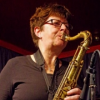Home » Jazz Articles » Album Review » The Casimir Connection: Cause and Effect
The Casimir Connection: Cause and Effect
McLoughlin is joined by three versatile musicians, violinists Pawel Grudzień and Kit Massey, and double bassist Tim Fairhill. The three are ideally suited to these hybrid soundscapes with their polyglot backgrounds in classical, folkloric and contemporary idioms. Grudzień doubles on piano throughout while Fairhill, of London Improvisers Orchestra fame, brings a spacious bottom end to proceedings. Unfortunately, soloists are not indicated on the album but suffice it to say the improvisations are uniformly strong.
The opener, "Eisenstein's Theory," sets the template, with composed and improvised parts clearly delineated. Circling piano motifs underpin melodic unison lines between saxophone and violin. A brief rubato passage forms a bridge to violin and soprano saxophone solos before the music quietly dissipates. "The Nurture of Nature" follows a similar pattern, though at a slower pace. Grudzień's gently hypnotic piano motif and Fairhill's sotto voce bass pulses provide a soft canvas for beautiful solos from violin and soprano saxophone on this soothing, bucolic meditation.
One can almost imagine a thumping bodhran driving the melody on "The Secretive Irishman" as it moves from plaintive air to dashing jig. The absence of drums in the quartet emphasizes the melodic, harmonic and emotional contours by default, though there is rhythmic verve in much of the playing. This is particularly true on "Up on The Moors"—with its striding pulse and McLoughlin's feisty soprano that evokes swirling winds—and on "Torch Song," a dancing, Balkanesque baton exchange between violins. A tempest of a different kind drives "The Storm Inside," a dramatic and, in turn, brooding piece, where a violin stirs and buzzes like an angry bee.
Some of McLoughlin's most affecting music lies in her more introspective pieces, such as the elegant "Contemplation" and "A Lonely Child," the latter a beautifully serene meditation built on a slowly circling piano figure and plaintive melody. Here, piano and soprano saxophone leave contrasting impressions—the former of aching melancholy, the latter a yearning quality. There is an almost cinematic vein in McLoughlin's pen at times—in the repeating string and piano motifs of "Lost in Color" resides just a hint of Phillip Glass' architecture. Violins trade back and forth with verve on "A Day in a Polish Village 1933," the album's most overtly Eastern European-influenced number.
Like a great landscape painting, the music reveals its details, its many layers, with repeated listening and contemplation. With Cause and Effect McLoughlin's The Casimir Connection has tapped into a rich musical seam, one which could yet offer plenty more of this timeless, yet borderless music.
Track Listing
Eisenstein’s Theory; The Nurture of Nature; The Secretive Irishman; A Lonely Child; Up on the Moors; Torch Song; Nadya; Lost in Color; The Storm Inside; A Day in a Polish Village 1933; Contemplation.
Personnel
Diane McLoughlin
saxophoneDiane McLoughlin: saxophones; Pawel Grudzień: violin, piano; Kit Massey: violin; Tim Fairhill: double bass.
Album information
Title: Cause and Effect | Year Released: 2019 | Record Label: Ciconia Records
< Previous
Chris Botti At The Charleston Music Hall
Next >
Geschmacksarbeit
Comments
About Diane McLoughlin
Instrument: Saxophone
Related Articles | Concerts | Albums | Photos | Similar ToTags
For the Love of Jazz
 All About Jazz has been a pillar of jazz since 1995, championing it as an art form and, more importantly, supporting the musicians who create it. Our enduring commitment has made "AAJ" one of the most culturally important websites of its kind, read by hundreds of thousands of fans, musicians and industry figures every month.
All About Jazz has been a pillar of jazz since 1995, championing it as an art form and, more importantly, supporting the musicians who create it. Our enduring commitment has made "AAJ" one of the most culturally important websites of its kind, read by hundreds of thousands of fans, musicians and industry figures every month.



















